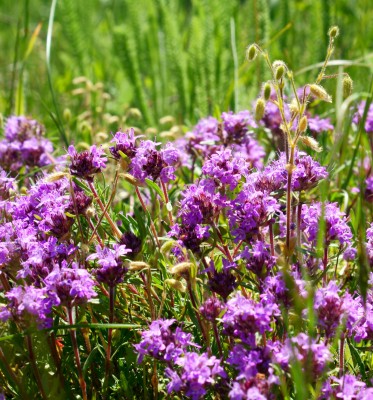Wild Thyme

Common Names: Wild Thyme, Creeping Thyme, Mother of Thyme, Breckland Thyme, Thymus serpyllum, Elfin Thyme, Motherwort, Serpolet, Matricaria, Douška mateří, Matěří, Tomillo serpol, Quendel, Mother Thyme, Mountain Thyme
Latin Name: Thymus serpyllum
Origin: Africa, Asia, Europe, South America, North America
Short Introduction
Wild Thyme is suitable for growing both in gardens and as an indoor plant on a sunny windowsill.
If planting outdoors, it thrives best in rock gardens. Wild Thyme prefers stony, dry, light, and warm environments—just be cautious of strong winds.
Sow seeds outdoors in late March or early April. the seeds are light-dependent for germination, so press them gently into the soil surface. Propagation is also possible by cuttings: take a stem up to 8 cm long and root it—but always avoid doing so in winter! Prune the plant by about a third after blooming (in spring) to encourage bushier, renewed growth.
Detailed Description
Our grandmothers brewed wild thyme tea—why shouldn't we enjoy it too?
Botanical Information
Wild Thyme (Thymus serpyllum) is a perennial herb reaching up to 30 cm in height. It features a creeping, woody rhizome from which stems arise, bearing leaves typically arranged in pairs opposite each other. The inflorescence resembles a small tuft, with a delicate and pleasant aroma. Its flowers are tiny and purple, blooming from May to August. While often confused with common thyme (Thymus vulgaris), wild thyme is a distinct species within the same genus.
Origin and Distribution
Wild Thyme is native to the Mediterranean region but is widely found throughout Central Europe, including the Czech Republic. Although once abundant, its population is slowly declining, but it is not yet listed as a protected species.
Usage / Dosage
Wild Thyme is traditionally recommended for maintaining healthy respiratory function and supporting normal digestion. It is recognized as an antioxidant and is valued for its positive effect on the body's natural defenses. Additionally, it serves as a culinary herb.
Active Compounds
Wild Thyme contains about 0.6% essential oil, predominantly carvacrol, cymene, and thymol. It also includes bitters, tannins, and flavonoids.
Traditional Dosage
Infusion: Pour 250 ml of boiling water over 2 teaspoons of dried herb and let it steep. Drink once or twice daily, sweetening with honey if desired.
Pillow Sachet: Fill a small cloth pouch with dried herb, sew it shut, and use as a pillow. The aromatic oils will gently release warmth and fragrance as you rest, promoting calm sleep.
Herbal Bath: Boil 200 g of dried wild thyme in water, strain, and add to your bath for a relaxing soak.
Herbal Oil for Back Pain and Rheumatism: Combine 60 g of dried wild thyme with 40 g of mint in 1 liter of oil. Let stand for 14 days, then strain. Use as needed on sore muscles or joints.
